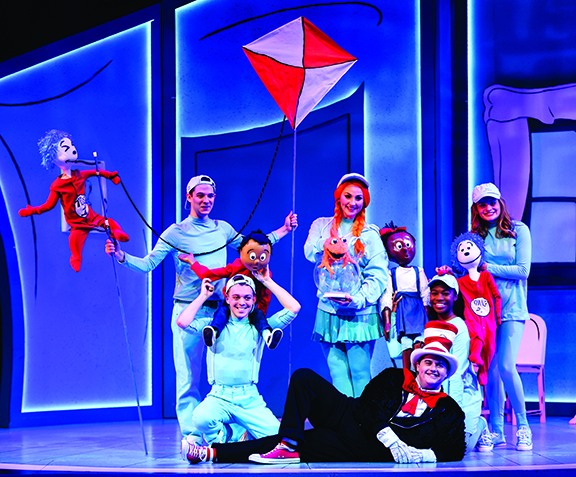Two Classic Stories Bring Theatre Magic to Oklahoma Audiences
[/et_pb_text][/et_pb_column][/et_pb_row][et_pb_row admin_label=”row” _builder_version=”3.25″ background_size=”initial” background_position=”top_left” background_repeat=”repeat”][et_pb_column type=”4_4″ _builder_version=”3.25″ custom_padding=”|||” custom_padding__hover=”|||”][et_pb_text admin_label=”Text” _builder_version=”4.0.11″ background_size=”initial” background_position=”top_left” background_repeat=”repeat”]
Cast of THE CAT IN THE HAT. Photo by K. Talley Photography
By RODNEY BRAZIL
When thinking about timeless children’s stories, the first titles that come to mind might be Rapunzel, Little Red Riding Hood, or Cinderella. Now entering its seventh decade in publication, The Cat in the Hat is poised to join these greats in the official canon of imaginative books for kids.
Written and illustrated by Theodore S. Geisel under his pen name, Dr. Seuss, the book has sold over 7,000,000 copies since it was introduced in 1957. It has been checked out at the New York Public Library 469,650 times, a record that exceeds both To Kill a Mockingbird and Harry Potter and the Sorcerer’s Stone.
A new stage adaptation of Dr. Seuss’ The Cat in the Hat is now playing at Lyric Theatre of Oklahoma. The production is sure to please even the most ardent fans of the book. Incorporating lively costumes, puppets and scenery all inspired by the original illustrations, the designers, cast and crew have used extensive theatre magic to bring the beloved tale to life.
Lexi Windsor portrays “Fish,” the cantankerous pet who has no patience for the unruly Cat in the Hat. Like many of us, she’s been a fan of Dr. Seuss books since being introduced as a child.
“Dr. Seuss’s way of drawing characters and creating a world paired with fascinating rhyme schemes is so incredibly interesting,” she said. “I imagine, when his books came out, it was highly innovative, introducing a whole new way of storytelling for children.”
Geisel began writing children’s books in response to widespread feelings that the go-to reading primers of the day, the Dick and Jane series, were not effective. The Cat in the Hat, his first attempt at a better option, sold over a million copies in the first three years.
“I love his artwork,” Windsor explained. “I went to a gallery in New Orleans dedicated to the art of Dr. Seuss. It included rough sketches of his famous characters, sculptures and paintings from his personal collection. I was in awe of his whimsy.”
Windsor also provided proof of her history with the book. She showed me her childhood copy of The Cat in the Hat, complete with chew marks from her childhood Maltese dogs, Lollipop and Tootsie Roll. “They loved that book, too!”

Puppetry is a big part of the magic in this production, and several techniques come into play.
Eli Bradley portrays “Boy,” brother of the character “Sally,” who is never given a name in the original book. Several different puppets create the Boy character for the show.
“We start with a traditional puppet show, where actors are performing behind a flat,” Bradley explained. “It’s minimal–a Punch and Judy theater type thing. Everything’s in miniature, but then, we open it up, and the world of The Cat in the Hat explodes. Suddenly it’s the full stage.”
Kaleb Michael Bruza plays “Thing 2” using several puppets to present each character. “The set, all of the props and the puppets were all ready to go, day one,” Bruza pointed out. “It was the largest boon in this process.”
“When you watch the show, it’s reminiscent of being a child tucked in to bed with Mom or Dad reading Dr. Seuss,” Windsor described. “But everything pops out! So it becomes a living pop-up book.”
Ultimately, all the visuals in the show unite to create a connection to the original book. “You can take the illustrations out of the book and hold them against the scenes we’re doing, and it’s very faithful,” Bruza commented.
“I think there is a nostalgia factor,” he elaborated. “Everyone read The Cat in the Hat as a kid and knows that it’s of quality. Then when they get older, they all read it to their children. It becomes a tradition.”

Eli Bradley, Josiah Brooks, and Lexi Windsor in THE CAT IN THE HAT. Photo by K. Talley Photography
Coincidentally, Windsor, Bradley and Bruza are all a part of Cinderella Interactive, a Lyric touring show that performs in schools across the state of Oklahoma.
Cinderella Interactive is a new stage adaptation of a classic story. It uses familiar songs from Rogers and Hammerstein’s musical and pairs them with a script by local playwright Justice von Maur. While watching the story of Cinderella, children learn concepts of story structure and technical theatre.
The origins of Cinderella aren’t entirely clear, but that doesn’t take away from the resonance of the story through time. “The Cinderella story is thousands of years old,” Bruza remarked. “Ancient Egypt and China both have these Cinderella-like stories. As similar as using a sandal to try and determine who the maiden was. But the exact origin is unknown. Someone, somewhere, told a good story, and it was passed down from parent to child for thousands of years.”
“It would be interesting to know if The Cat in the Hat will still be popular in a thousand years?!” Windsor added.
While both shows fall within the realm of theatre for young audiences, often initialized within arts circles as TYA, but each production serves a different purpose. “Both of the shows are kind of self-aware–they are both meta-theatrical,” Bradley suggested. “In Cinderella, we stop and comment on the action and explain what just happened, but none of that happens in The Cat in the Hat. Here, we still manipulate space and time, but with puppets instead of commentary.”
Each of these TYA shows was chosen by the Lyric artistic team to further the mission of introducing the art of theatre to Oklahoma’s children. For both, the alchemy of story and visuals is key to keeping children engaged.
After every performance of Cinderella Interactive, a similar line of questions inevitably come up. “Those kids are in love with Jeffrey Meek’s costumes,” Windsor declared. “We always hear, ‘How did you change so fast?’ and ‘Who made your costumes?’ Jeffrey truly created a fairy tale with those costumes so that we can go on stage and make magic.”
[/et_pb_text][/et_pb_column][/et_pb_row][/et_pb_section]













